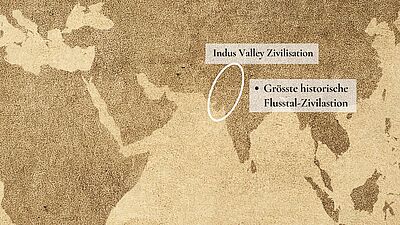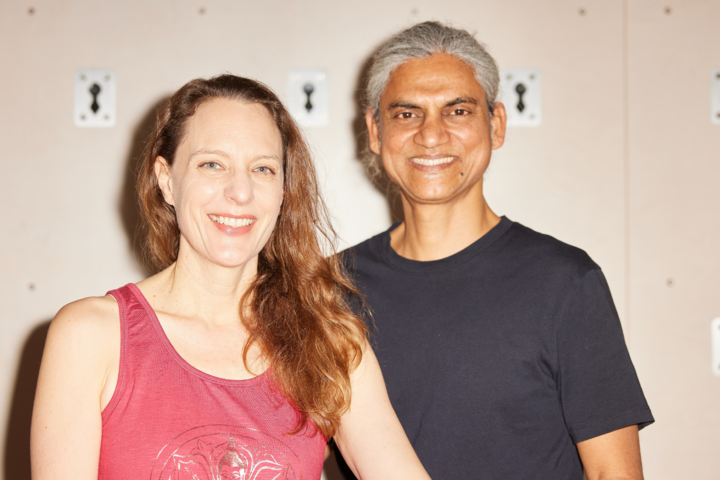What is the difference between Hatha Yoga, meditation and Raja Yoga according to Patanjali?
Hatha yoga, meditation and raja yoga – what is it all about?
This article is intended to provide clarity on the subject of Hatha Yoga, meditation and Raja Yoga, whose Yoga Sutras are widely read in yoga teacher training courses. I explain where the differences lie, how the terms originated, where they merge and why Patanjali was not a Hatha yogi.
A little about the history of yoga
Overlapping with Hatha Yoga and Raja Yoga
What does Patanjali's Yoga Sutras say about yoga asana?
Yoga Asana – just a sitting position or more?
What if I am more interested in the physical exercises than in meditation?
What is Hatha Yoga?
Hatha yoga was first mentioned in writing in the 15th century AD in the text written by Swami Swatmarama, the Hatha Yoga Pradipika. This author explains very clearly at the very beginning of his text that Hatha yoga is only a means to an end, to attain Raja yoga.
This is a very important core statement and we will come back to it – so remember it.
The focus of Hatha Yoga is primarily on the physical aspects of yoga as a means of preparing for deeper spiritual practices.
The practice includes physical exercises that are designed to cleanse and strengthen the body, balance the mind and prepare for meditation. These include:
Asana (physical exercises)
pranayama (breath control)
mudras (gestures), bandhas (energy locks)
cleansing techniques (Shatkarmas).
Let me say right away: from our personal point of view, not all the practices from the Yoga Pradipika are equally useful, some of them are even rather harmful. It is important to question such practices, not everything that is “old” is also wise. Here I am referring mainly to the various cleansing practices or pranayama, some of which are extremely invasive or aggressive and should be viewed with some distance from today's perspective.
As mentioned, the goal of Hatha Yoga is to create a strong and healthy body and mind that serves as the basis for higher states of meditation and spiritual awakening. And that, in turn, is known as Raja Yoga.
What is Raja Yoga?
Raja Yoga is also known as the “royal path” or “king of yoga”. It focuses on the mind, how to deal with thoughts and meditation. Raja Yoga is more concerned with the mental and spiritual aspects of yoga, rather than the physical ones. It is the path to enlightenment through meditation.
Raja Yoga follows, among other things, an eight-part or eight-stage path (Ashtanga), as described by the sage Patanjali in the Yoga Sutras. This text systematically outlines the philosophy and practice of Raja Yoga, including the eight stages of Raja Yoga:
Yama & Niyama (describes ethical principles and how to treat oneself and others)
Asana (posture)
Pranayama (breath control - breathing exercises)
Pratyahara (withdrawal of the senses)
Dharana (concentration)
Dhyana (meditation/mindfulness)
Samadhi (enlightenment)
The main goal of Raja Yoga is to achieve self-realization and liberation (moksha) through the mastery of the mind and thoughts, as well as through deep meditation. The aim is to achieve mental control (thought control) and spiritual enlightenment.
A little about the history of yoga
Scholars date the composition of Patanjali's Yoga Sutras to between the 2nd century BC and the 4th century AD. However, it is a proven fact that yoga, as described in the sutras of Raja Yoga, has existed for much longer. The knowledge was traditionally passed on orally from teacher to student, and Patanjali was the first (or so it is assumed) to write down the knowledge in short sentences (sutras).
In the Indus Valley, there are excavation sites from the Indus Sarasvati civilization (Harappa civilization) that provide evidence that yoga was taught several thousand years ago. The Indus Sarasvati civilization originated around 7000 BC and flourished between around 3000 BC and 1900 BC, with a population of around 5 million. Some scientists believe that its origins could go back even further (10,000–15,000 BC). This would be around the end of the Ice Age.
We also learned that the Hatha Yoga Pradipika was written in the 15th century AD; an enormous time gap!
What are the Yoga Sutras of Patanjali
Anyone who has studied the Yoga Sutras of Patanjali knows that it is a book with four chapters and a total of 196 verses (sutras). It is interesting that the book begins with the chapter on Samadhi Pada. This chapter is not aimed at beginners on the path of yoga or beginners in meditation, but at those who are already advanced on their path. And as I said, advanced in terms of Raja Yoga (meditation), not in terms of Hatha Yoga.
The second chapter is called Sadhana Pada and is aimed at those who want to start with Raja Yoga or meditation.This chapter also includes the often-mentioned 8 stages of the yoga path. Yama & Niyama (ethical principles and how to treat yourself and others), Asana (posture), Pranayama (breath control), Pratyahara (withdrawal of the senses), Dharana (concentration), Dhyana (meditation/mindfulness) and Samadhi (enlightenment). The last three stages (Dharana, Dhyana and Samadhi) are described in the third chapter, the Vibhuti Pada. There, Patanjali describes what happens when you have mastered the first five steps and the other teachings of the Sadhana Pada.
Where do Hatha Yoga and Raja Yoga overlap?
Anyone who trains to become a yoga teacher will usually learn something about the Yoga Sutras of Patanjali. It is an integral part of the Yoga Alliance curriculum. Of course, every yoga teacher interprets the Yoga Sutras differently, but it is important to understand that the Yoga Sutras belong to Raja Yoga (Patanjali) and not to Hatha Yoga.
In chapter 2 of the Yoga Sutras, Sadhana Pada, 5 of the 8 stages of yoga are explained and the 3rd stage includes asana, the physical exercises.
Those who associate yoga purely with physical exercises and study the Yoga Sutras are likely to be surprised, because there are only three sutras on this topic! And these sutras are explanations of how to sit down for meditation. They do not deal with how to do the headstand or the downward-facing dog, etc.
Asana is often translated as yoga exercises or physical exercises, and we use the term in this way at our yoga studio in Zurich (The Yoga Place). But the word asana comes from the root -as in Sanskrit (the language in which the Yoga Sutras were written), which means “to sit”. It therefore describes a sitting position.
What does Patanjali's Yoga Sutras say about yoga asana?
The following is written in the three Yoga Sutras on Asana:
2.46 The posture (asana) should be calm, stable, motionless and comfortable, and this is the third of the eight rungs of yoga. (sthira sukham asanam)
2.47 The means for perfecting the posture is to relax or loosen the effort and allow the attention to merge with the infinite. (prayatna shaithilya ananta samapattibhyam)
2.48 From the attainment of this perfected posture, an unassailable, unimpeded freedom from suffering arises due to pairs of opposites (such as heat and cold, good and bad, or pain and pleasure). (tatah dvandva anabhighata)
These three sutras can be applied to all yoga asanas (yoga exercises), even though in the context of Raja Yoga they refer to the sitting posture during meditation.
And all yoga exercises should be practiced with exactly this quality and mindset, because that is how they take on a meditative character. If we then understand that it is not about the exercise itself, but about the purpose we want to achieve with it, then we have already understood a great deal about yoga.
Yoga Asana – just a sitting position or more?
The chosen posture should therefore be calm, stable and motionless, as well as comfortable. Well, then I'd better lie down to meditate, you might think.
But no, unfortunately you can't meditate lying down! For meditation you have to sit, and in such a way that your head, neck and torso are in one line, whereby the natural curvature of the spine must be maintained.
However, relaxation or mindfulness / awareness exercises can also be done lying down.
Thousands of years ago, people didn't have chairs and usually sat on the floor, which is how the various sitting positions for meditation came about. Today, you can certainly meditate on a chair. This makes meditation easier for many people.
However, beginners find it difficult to sit for longer periods of time, even if a chair is available. The body is simply not ready for a longer meditation, let alone the mind, which is constantly bouncing back and forth.
I think that the author of the Hatha-Yoga Pradipika (Swami Svatmarama) also saw this in his students, whom he wanted to teach Raja Yoga and therefore wrote this text about Hatha Yoga.
Because a body that is not free of pain, illness or toxins finds it much more difficult to meditate. This is where Hahta Yoga comes in. Personally, I think that Hatha Yoga, like Raja Yoga, goes back much further in history than is generally assumed, and it makes sense that it was taught in some form or other as a preparation for Raja Yoga thousands of years ago.
However, since Patanjali addressed the Yoga Sutras to advanced students, he probably already assumed that their body and mind were ready for the next step.
Through various physical exercises, the body becomes stronger and more flexible. The mind can calm down faster and the breathing exercises also help to tame the thoughts. After that, it is easier to meditate.
And as mentioned earlier in the text, if you hold your yoga exercise for a moment, it is stable and calm, almost motionless, but you remain relaxed inside and do not “contract” in the exercise and can remain aware, then a whole new quality arises - your asana practice becomes a meditation!
You won't achieve this effect if you quickly switch from one exercise to another while listening to music in the background. In our yoga studio in Zurich, we practice the yoga asana (yoga exercises) in a meditative way, as described by Patanjali, and also combine them with correct alignment so that we don't injure ourselves.
Yoga should not be about the external aspect of the body. As explained in the introduction to the Hatha Yoga Pradipika, yoga exercises are only a means to an end. The end is meditation, which enables us to achieve liberation. Liberation from our small “I”, which we cling to so tightly, to a greater “I” that has so much potential.
The limits of Hatha Yoga
We do not achieve this liberation through yoga exercises, breathing exercises or cleansing techniques, no matter how well we do them. To attain liberation, we need good and, above all, safe (!) meditation techniques that can fill our body with spiritual energy, and we must follow the 8 stages of Raja Yoga.
In the past, it was even the case that “extreme” hatha yogis or yoginis were not allowed to practise higher meditation techniques because their subtle bodies were too “dense”, which hindered the free flow of subtle energy in higher meditations.
Today we see that those who only care about the external (the yoga asana) often become somewhat hard and brusque in their personality, and this is also reflected in their dealings with other people, which is not at all in line with the values of yoga!
What if I am more interested in physical exercises than in meditation?
As already explained, the third stage of the eightfold path of yoga according to Patanjali is asana. Asana is often translated as physical exercises. In our Alignment Yoga School, The Yoga Place in Zurich, we do spend a lot of time in the regular group classes teaching the various yoga asanas correctly and safely and conveying the “mindset” of non-competitive or comparative practice, because yoga is not a sport!
Most people come to our yoga classes because they want to understand the yoga exercises better and not get injured. They want to do something good for their bodies and just get away from the constant stress of everyday life. For many, that's enough at the beginning; they don't want to have to sit down and meditate.
That's absolutely fine, and Joey and I respect that. But we are always aware of why we do what we do. Even though we give very detailed and precise instructions, take into account the anatomy of the people who come to us for yoga and help them to feel better, we never lose sight of the ultimate goal of what yoga is really about.
We personally practise a synthesis of Raja and Alignment based Hatha Yoga, as well as other meditation techniques that can be learned in the “Path to Arhatship”.
We see everyone who comes through our door as a soul in a human body that wants to develop during their time on earth. We leave it up to the individual to decide how they want to use our entire yoga program to do so.
Anyone who simply wants to do yoga exercises is just as welcome as someone who wants to delve deeper into the subject through an alignment yoga teacher training course or simply wants to develop spiritually.
What we will never be is a yoga studio that is purely about showing off the body or outward appearances.
We are not a sports studio or a workout place, and certainly not a New Age or yoga scene “hangout”. We are an alignment-based Hatha yoga studio in Zurich. Alignment in terms of posture, but also in terms of the soul, thus we bridge the gap between Hatha and Raja yoga.
Summary of Hatha Yoga vs Raja Yoga
Raja yoga and hatha yoga overlap in the third stage of the eightfold path of yoga according to Patanjali. In the Yoga Sutras, asana is a sitting posture that one should adopt for meditation. Hatha yoga builds on this stage through various yoga exercises, adding breathing exercises, mudras and cleansing techniques to help the body prepare better for meditation (Raja yoga).
Hatha Yoga: focuses on physical exercises (asanas, pranayama) to prepare the body for deeper meditation and spiritual practices. Its emphasis is on physical cleansing and the control of vital energy (prana).
Raja Yoga: Focuses on mental and spiritual practices to achieve self-realization and liberation. Its emphasis is on controlling the mind, dealing with one's own thoughts and achieving higher states of consciousness. In simple terms, it is the path of meditation.

![[Translate to EN:] [Translate to EN:]](/fileadmin/_processed_/f/2/csm_2_637c199589.jpg)



